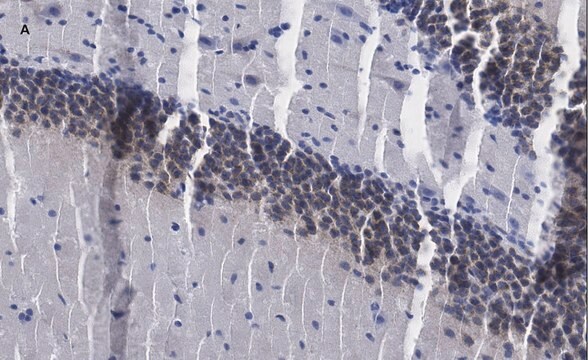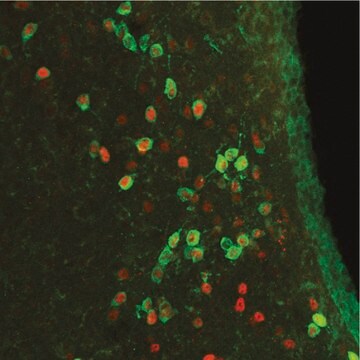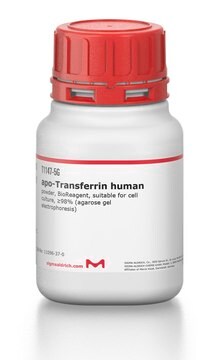PC05
Anti-c-Fos (Ab-2) (4-17) Rabbit pAb
liquid, Calbiochem®
Sign Into View Organizational & Contract Pricing
All Photos(1)
About This Item
UNSPSC Code:
12352203
NACRES:
NA.41
Recommended Products
biological source
rabbit
Quality Level
antibody form
purified antibody
antibody product type
primary antibodies
clone
polyclonal
form
liquid
contains
≤0.1% sodium azide as preservative
species reactivity
human, mouse, rat
manufacturer/tradename
Calbiochem®
storage condition
do not freeze
isotype
IgG
shipped in
wet ice
storage temp.
2-8°C
target post-translational modification
unmodified
Gene Information
human ... FOS(2353)
General description
Protein A purified rabbit polyclonal antibody. Recognizes v-fos and ~50-62 kDa c-fos proteins.
Recognizes the ~50-62 kDa c-Fos protein in HepG2, NIH3T3, and MCF-7 cells.
The proto-oncogene fos has been implicated in cell growth, differentiation and development. Fos is induced by a large number of stimuli including mitogens, differentiation-specific agents, pharmacological agents, etc. Induction of the 62,000 dalton fos protein is rapid but transient. The fos protein is associated with a 39,000 dalton protein which has been identified as the protein product of the jun proto-oncogene (c-jun). The fos/jun protein complex binds specifically to a sequence element in DNA referred to as the AP-1 binding site.
This Anti-c-Fos (Ab-2) (4-17) Rabbit pAb is validated for use in Frozen sections, Immunoblotting, IF, IP, Paraffin sections, for the detection of c-Fos (Ab-2) (4-17).
Immunogen
Human
a synthetic peptide (SGFNADYEASSSRC) (Cat. No. PP10) corresponding to amino acids 4-17 of human c-Fos
Application
Frozen sections (5-10 µg/ml)
Immunoblotting (1-5 µg/ml)
Immunofluorescence (1-5 µg/ml)
Immunoprecipitation (1-2 µg/reaction)
Paraffin sections (5-10 µg/ml, pepsin or heat pre-treatment required)
Free-floating Sections (not recommended)
Immunoblotting (1-5 µg/ml)
Immunofluorescence (1-5 µg/ml)
Immunoprecipitation (1-2 µg/reaction)
Paraffin sections (5-10 µg/ml, pepsin or heat pre-treatment required)
Free-floating Sections (not recommended)
Packaging
Please refer to vial label for lot-specific concentration.
Warning
Toxicity: Highly Toxic (H)
Physical form
In 0.05 M sodium phosphate buffer, 0.2% gelatin.
Analysis Note
Positive Control
HepG2, NIH 3T3 cells, MCF-7 cells, colon or breast adenocarcinoma tissue
HepG2, NIH 3T3 cells, MCF-7 cells, colon or breast adenocarcinoma tissue
Other Notes
DeTogni, P., et al. 1988. Cell Biol.8, 2251.
Rouscher III, F.J., et al. 1988. Science240, 1010.
Sassone-Corsi, P., et al. 1988. Cell54, 553.
Verma, I.M. and Graham, W.R. 1987. Cancer Res.49, 29.
Verma, I.M. and Sassone-Corsi, P. 1987. Cell51, 513.
Muller, R. 1986. Biochim. Biophys. Acta823, 207.
Verma, I. 1986. Trends Genet.2, 93.
Greenberg, M. and Ziff, E. 1984. Nature (London), 311, 433.
Rouscher III, F.J., et al. 1988. Science240, 1010.
Sassone-Corsi, P., et al. 1988. Cell54, 553.
Verma, I.M. and Graham, W.R. 1987. Cancer Res.49, 29.
Verma, I.M. and Sassone-Corsi, P. 1987. Cell51, 513.
Muller, R. 1986. Biochim. Biophys. Acta823, 207.
Verma, I. 1986. Trends Genet.2, 93.
Greenberg, M. and Ziff, E. 1984. Nature (London), 311, 433.
For gel shift assays, use Cat. No. PC05L resuspended in 100 µl of buffer. The immunogen, c-fos (Peptide-2), Cat. No. PP10, is also available for competition studies (see Murphy, et al. below). Antibody should be titrated for optimal results in individual systems.
Legal Information
CALBIOCHEM is a registered trademark of Merck KGaA, Darmstadt, Germany
Not finding the right product?
Try our Product Selector Tool.
Storage Class Code
10 - Combustible liquids
WGK
nwg
Certificates of Analysis (COA)
Search for Certificates of Analysis (COA) by entering the products Lot/Batch Number. Lot and Batch Numbers can be found on a product’s label following the words ‘Lot’ or ‘Batch’.
Already Own This Product?
Find documentation for the products that you have recently purchased in the Document Library.
Heinrich Gompf et al.
Anesthesiology, 111(5), 1001-1009 (2009-10-08)
One underexploited property of anesthetics is their ability to probe neuronal regulation of arousal. At appropriate doses, anesthetics reversibly obtund conscious perception. However, individual anesthetic agents may accomplish this by altering the function of distinct neuronal populations. Previously the authors
Elizabeth J Glover et al.
Alcoholism, clinical and experimental research, 40(8), 1651-1661 (2016-07-09)
While the rewarding effects of alcohol contribute significantly to its addictive potential, it is becoming increasingly appreciated that alcohol's aversive properties also play an important role in the propensity to drink. Despite this, the neurobiological mechanism for alcohol's aversive actions
N Laflamme et al.
Journal of molecular neuroscience : MN, 8(3), 165-179 (1997-06-01)
The purpose of this study was to investigate the effect of the immune activator lipopolysaccharide (LPS) on the expression of corticotropin-releasing factor (CRF) and glucocorticoid receptor (GR) mRNA in the paraventricular nucleus (PVN) of transgenic mice with impaired GR function
R R Gainetdinov et al.
Proceedings of the National Academy of Sciences of the United States of America, 98(20), 11047-11054 (2001-09-27)
In the brain, dopamine exerts an important modulatory influence over behaviors such as emotion, cognition, and affect as well as mechanisms of reward and the control of locomotion. The dopamine transporter (DAT), which reuptakes the released neurotransmitter into presynaptic terminals
Kristen M Smith-Edwards et al.
Gastroenterology, 157(2), 522-536 (2019-05-11)
Proper colon function requires signals from extrinsic primary afferent neurons (ExPANs) located in spinal ganglia. Most ExPANs express the vanilloid receptor TRPV1, and a dense plexus of TRPV1-positive fibers is found around myenteric neurons. Capsaicin, a TRPV1 agonist, can initiate
Our team of scientists has experience in all areas of research including Life Science, Material Science, Chemical Synthesis, Chromatography, Analytical and many others.
Contact Technical Service







